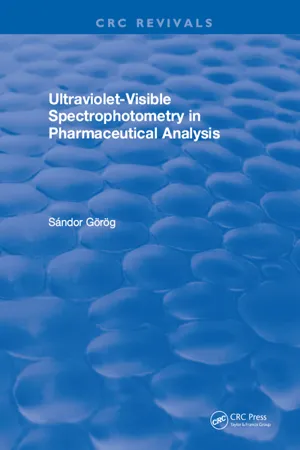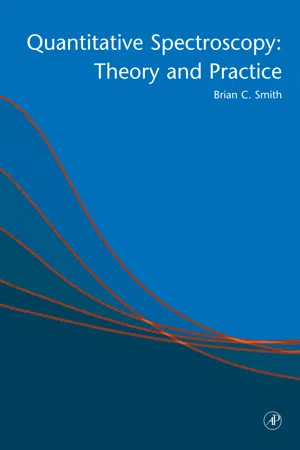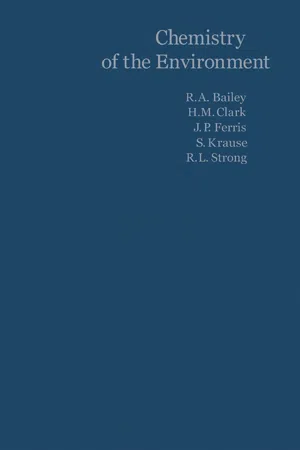Chemistry
Beer-Lambert Law
The Beer-Lambert Law, also known as the Beer-Lambert-Bouguer Law, describes the relationship between the concentration of a substance and the amount of light it absorbs. It is commonly used in chemistry to measure the concentration of a solute in a solution by analyzing the absorbance of light at a specific wavelength. The law is expressed as A = εlc, where A is absorbance, ε is molar absorptivity, l is the path length, and c is concentration.
Written by Perlego with AI-assistance
Related key terms
1 of 5
7 Key excerpts on "Beer-Lambert Law"
- eBook - PDF
Basic Bioscience Laboratory Techniques
A Pocket Guide
- Philip L.R. Bonner, Alan J. Hargreaves(Authors)
- 2022(Publication Date)
- Wiley-Blackwell(Publisher)
This relation- ship is linear, in that, as the concentration of a solution increases, so does the absorbance. In a similar manner, the longer the path length that light must travel through a solution before reaching the detector, the greater the chance a photon will be absorbed. Therefore, absorbance is also related to the path length the light must travel through the solution (see Figure 3.6b). The Beer–Lambert law states that the absorbance of a solution is a function of three factors: • The path length (L) of the light must pass through the cuvette holding the solution (this has been stand- ardized in most laboratory instruments to be 1.0 cm). The wells of a 96 well microplate will have a different pathlength for different volumes. The manufacturers will supply the relevant pathlength). • The concentration (C) of the reagent in molarity (M). • The absorptivity coefficient (ε), which is characteristic of the analyte in solution (ε is called the molar absorptivity coefficient (M −1 cm −1 ) if the concentration is measured in molar (M); see Chapter 1). 3 The Beer Lambert Law Absorbance – : A L C where ε, molar absorptivity coefficient (M −1 cm −1 ); C, molar concentration of solute (M); L, the path length of sample cell/cuvette or microplate well (cm). Absorbance displays a simple dependence on the concentration of a solution and the path length the light must travel through (The Beer–Lambert Law). This relationship allows scientists to convert an absorbance value from a spectrophotometer into a concentration, thus making the change in absorbance a quantifiable value DETECTOR (b) (a) DETECTOR A 0.5 A 0.5 (i) (ii) Io Io A 1.5 A 1.5 Io Io I I Figure 3.6 Beer–Lambert Law is related to (a) the concentration of the sample (the concentration of the cuvette (ii) is three times the concentration in cuvette (i). - eBook - ePub
Brewing Materials and Processes
A Practical Approach to Beer Excellence
- Charles W Bamforth, Charles Bamforth(Authors)
- 2016(Publication Date)
- Academic Press(Publisher)
λ .Absorption is directly proportional to the length of the path along which the light beam travels (this is the Bouguer–Lambert part of the law). Given that the absorption of a sample measured in 1 cm, the standard path, is known the absorption in 2, 5, or 10 cm is easily obtained by scaling by those factors. Second, as the absorption is proportional to the concentration, one can, given an absorption measurement on a standard of known concentration, determine the concentration of a solution of unknown concentration based on an absorption measurement made upon it, or given the absorption at a particular concentration, obtain the absorption at any other simply by scaling by the ratio of the concentrations. This is the Beer part of the law.Third, under the assumption that the probabilities of photon absorption by individual molecules are independent, we can calculate the absorption of a solution containing other color-absorbing substances from the sum of the individual absorptions:A( λ )= l∑ ic iα i( λ )In computing the visible colors of beer, we need the amount of light transmitted rather than its logarithm and so work with transmission spectra which are simply obtained from absorption spectra by taking antilogarithmsT( λ )=10− A( λ )0 ≤ A (λ ) < ∞ implies that 0 ≤ T (λ ) ≤ 1. Given a transmission spectrum, T (λ ), the absorption spectrum is easily obtained fromA( λ )= − log( T( λ ))Implications of the CNS hypothesis
The near validity of the CNS hypothesis implies thatA( λ )≈ l A(λ n)a ¯( λ )which, by comparison with the Bouguer–Beer–Lambert law, implies that beers and worts contain a single colorant material with molar extinctionαand molar concentration A (λ n ). As the CNS is normalized to wavelength λ n = 430( λ )=a ¯( λ ) - S. Gorog(Author)
- 2018(Publication Date)
- CRC Press(Publisher)
a.A = log= a ⋅ b ⋅ cI 0I(2.8) This is the fundamental equation of spectrophotometry. It is generally cited in the literature as the Beer-Lambert Law or Bouguer-Lambert-Beer Law (BLB). Since in spectrophotometric practice it is usually the dependency of the attenuation of light intensity on a concentration only which is of importance, it is often simply referred to as Beer’s Law.As is clear from the previous discussion, log I0 /I is a quantity of fundamental importance in spectrophotometry and therefore it has been given a separate name: absorbance (A) or, in the early literature, extinction (E). Absorbance is a linear function of the pathlength and the concentration of the absorbing solute but it is independent of the intensity of the incident light. Absorbance is the quantity that is usually directly read on the scale of spectrophotometers.The constant a of Equation 2.8 has to be dealt with separately. This does not depend on the pathlength and the concentration, but it is a function of the wavelength of the incident monochromatic light and the character of the absorbing substance. If both the concentration of the dissolved absorbing substance and the cell thickness are selected as unity (1 g/100 ml or 1 mol/liter and 1 cm, respectively), then according to Equation 2.8 :A = a(2.9) The value of a depends on the mode of presentation of the concentration. If it is expressed as w/v percent, the proportionality factor a is termed specific absorbance(or, in the early literature, specific extinctionA | cm | %)(. If the concentration is expressed as molarity, the name of a is molar absorptivity (ɛ) or, in the early literature, molar extinction coefficient. The relation between the two coefficients can be given by Equation 2:10E | cm | %)- Brian C. Smith(Author)
- 2003(Publication Date)
- Academic Press(Publisher)
the sample is homogeneous. Remembering that the integral of any quantity 1/1^ is In X, we can apply this to Equation (1.10) and evaluate the integrals to obtain n(Io/I) = 6cL (1.11) Equation (1.11) is one way of stating Beer's law. However, it is traditional to express Beer's law using base 10 logarithms rather than natural logarithms. Recall that ln(10) = 2.303. We divide the right-hand side of Equation (1.11) by 2.303, which we will wrap into the absorptivity and rewrite to obtain og(Io/I) = scL (1.12) To simpUfy Equation (1.12), we define a new quantity called the absorbance, denoted by A and given by ^=log(/o//) (1.13) and this allows us to rewrite Beer's law one last time to obtain its final form A = 8lc (1.14) where A = absorbance £ = absorptivity / = pathlength c = concentration 1. FUNDAMENTALS OF MOLECULAR ABSORPTION SPECTROSCOPY 13 This is the form in which Beer's law is most commonly expressed, and will be the form used throughout this book. What this equation tells us is that the amount of light absorbed by a sample depends on the concentration of the analyte, the thickness of the sample, and the sample's absorptivity. Also, note that the relationships in Beer's law are Hnear. For example, doubling the pathlength or concentration of a sample doubles its absorbance. Many spectrometers are capable of measuring spectra with the F-axis in absorbance units. An example of a spectrum plotted in absorbance units is seen in Figure 1.1. Because the relationship between absorbance and concentration is Hnear, the peak height or area of an analyte's absorbance band will vary hnearly with concentration. Sometimes spectra are plotted with the F-axis units in transmittance, which is defined as follows T = {I/Io) (1.15) where r:= transmittance The 7-axis values in a transmittance spectrum can vary from 1, when I=Io, to 0 when 7=0 (this means no hght is being passed by the sample). Transmittance measures the fraction of light transmitted by the sample.- eBook - ePub
Introductory Bioelectronics
For Engineers and Physical Scientists
- Ronald R. Pethig, Stewart Smith(Authors)
- 2012(Publication Date)
- Wiley(Publisher)
Equation (4.1) no longer holds at very high values of the absorbance. The critical level for this will depend on the concentration of the analyte and its molar absorption coefficient. A value of [C] larger than around 10 mM often merits caution in this respect. At high concentrations analyte molecules in close proximity with each other can experience electrostatic interactions, which can alter the absorbance coefficient ε as well as the refractive index of the sample. At higher concentrations and longer pathlengths there is also an increasing probability that two or more absorbing species will lie in the same optical path. This will lead to an underestimate of the molar absorption coefficient. The chemical equilibrium of some samples (e.g. dissociation of molecular salts) can also shift with increasing concentration. Active fluorescence or phosphorescence of the sample, as well as the scattering of light by particulate matter can also limit the linearity of the Beer-Lambert Law. Practical limitations can also occur as a result of stray light entering the sample or the optical system. Because the absorbance coefficient ε is a function of wavelength, the use of nonmonochromatic radiation can lead to errors. This can be minimised if measurements can be made in a wavelength region close to a maximum absorption band having a relatively flat profile. The incident radiation should also take the form of parallel light rays, all of which travel the same distance through the sample.Example 4.2A sensor operates on the principle that an immobilised reagent R of known molar absorption coefficient will change colour when it reacts with a target analyte A to form a chemical complex according to the reaction . The chemical equilibrium constant K is known for this reaction. Can the analyte concentration be determined by measuring the height of the distinct absorption peak of the AR complex?Solutions:The chemical equilibrium constant K for the reaction is given by:(4.6)The total concentration R of the immobilised reagent is given by the sum of the free reagent available for the reaction and the amount already present in the complex:(4.7)Substituting [AR] from Equation (4.6) into Equation (4.7) :(4.8)Substituting this result into Equation (4.7) we obtain:(4.9)This equation does not provide a simple linear relationship between the concentration of the analyte [A ] and the absorption peak measured for the complex [AR ] and the concentration of the analyte [A ]. At sufficiently low analyte concentrations (where [A ] 1/K ), Equation (4.9) predicts that the absorbance will be proportional to [A ]. With increasing analyte concentration the absorbance will increase and approach a constant level for [A ] 1/K - eBook - PDF
Physical Chemistry
Understanding our Chemical World
- Paul M. S. Monk(Author)
- 2005(Publication Date)
- Wiley(Publisher)
where k is merely an empirical constant. An alternative way of presenting this law is to note that a graph of absorbance A (as ‘y ’) against concentration c (as ‘x ’) will be linear. Figure 9.9 shows such a graph for the permanganate ion in water as a function of concentration. Equation 9.9 also suggests the (hopefully obvious) corollary that Beer’s law requires monochromatic light because the value of k depends on λ. an absorbing sample has no absorbance if its concentration is zero. In other words, we have no absorbance if there is no sample in solution to absorb, which is why the extrapolation of the line in Figure 9.9 passes through the origin. Why does a glass of apple juice appear darker when viewed against a white card? The Lambert law Apple juice usually has a pleasant pale orange–yellow colour. But, if the glass is held against a white card or curtain, the intensity of the colour appears to increase significantly – it may look brown. It appears darker when held against a white card because light travels through the glass and juice twice : once before striking the white INTRODUCTION TO PHOTOCHEMISTRY 443 0 0.2 0.4 0.6 0.8 1 1.2 1.4 1.6 0 0.0001 0.0002 0.0003 0.0004 Concentration/mol dm −3 0.0005 0.0006 0.0007 Absorbance A Figure 9.9 An illustration of Beer’s law: absorbance of solutions of permanganate ion MnO 4 − as a function of concentration. The optical path length l was 1 cm, and the wavelength of observation was 523 nm back card, and a second time after light reflects off the card, as shown schematically in Figure 9.10. We say that the optical path length has doubled. This length is usually symbolized as l . A similar optical effect is seen at the swimming baths. The water at the deep end appears to have a more intense blue colour than at the shallow end. Again, this intensification of colour arises because the path length l alters. Again, the photograph in Figure 9.11 shows the view around the coast of Hawaii. - eBook - PDF
- R.A. Bailey(Author)
- 2012(Publication Date)
- Academic Press(Publisher)
If c is given in molarity M (moles/liter) and χ in centimeters, G has the units M 1 cm 1 , and is called the molar extinction coefficient. On the other hand, if the concentration is The constant α is also sometimes called the extinction coefficient. In usage here, however, we shall always refer to the extinction coefficient as the constant 6 in the Beer-Lambert Law in the decadic form. 224 CHEMISTRY OF THE ENVIRONMENT expressed in molecules per cubic centimeter, then the extinc-tion coefficient has the units square centimeter per molecule and is the molecular absorption cross section σ. Frequently, however, in gaseous systems such as the atmosphere, it is convenient to express the concentration in pressure units; these are generally related to concentration units at low pressures by the ideal gas equation Ρ = (n/V)RT = cRT , and therefore the temperature must be specified. Strictly speaking, the Beer-Lambert Law applies only to monochromatic radiation since S is a function of wavelength. The extent to which use of nonmonochromatic light leads to significant error in the determination of concentration depends on the spectral characteristics of the absorbing and illuminating system. If the extinction coefficient and incident intensity are known as functions of wavelength, how-ever, the total amount of light absorbed may be obtained by integrating over all wavelengths. Also, if there are i absorbing species or components present, the Beer-Lambert becomes I/I = 10 ElGlCiX) (9.11) 9.3 KINETICS OF THERMAL PROCESSES Most chemical reactions are kinetically complex, that is, they take place by a series of two or more consecutive steps (the mechanism of the reaction) rather than by a single encounter of the reacting species. Nevertheless, the overall reaction between, say, two reactants A and Β can be repre-sented by the generalized equation aA + bB > cC + dO (9.12) Where the stoichiometry of the reaction is given by the coefficients a, b, etc.
Index pages curate the most relevant extracts from our library of academic textbooks. They’ve been created using an in-house natural language model (NLM), each adding context and meaning to key research topics.






